#Architectural Rendering Cost
Text
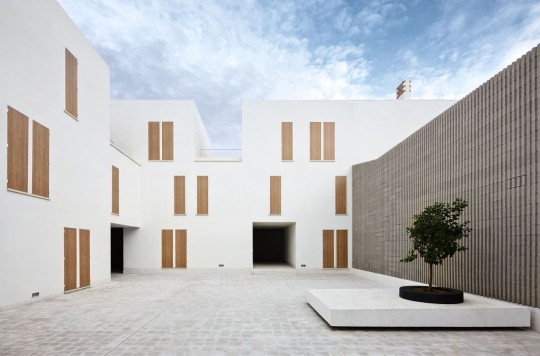
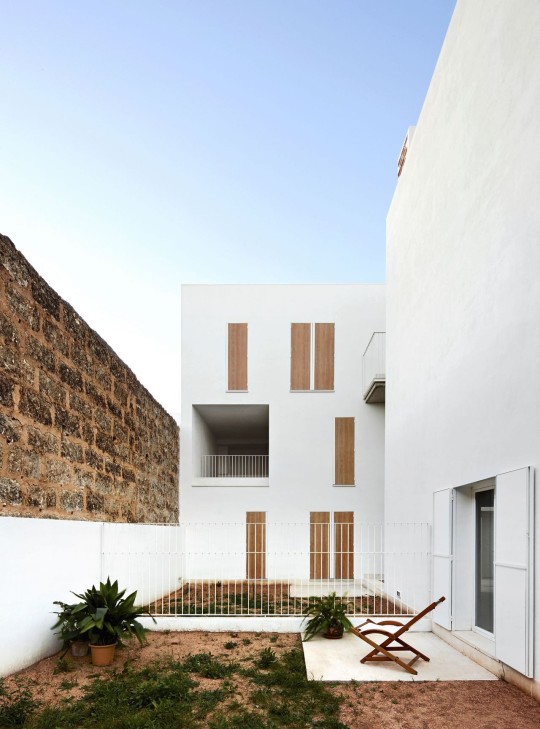
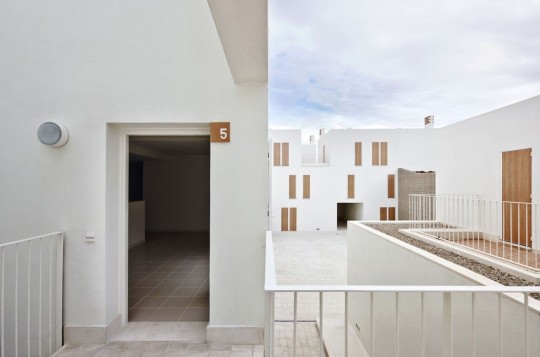
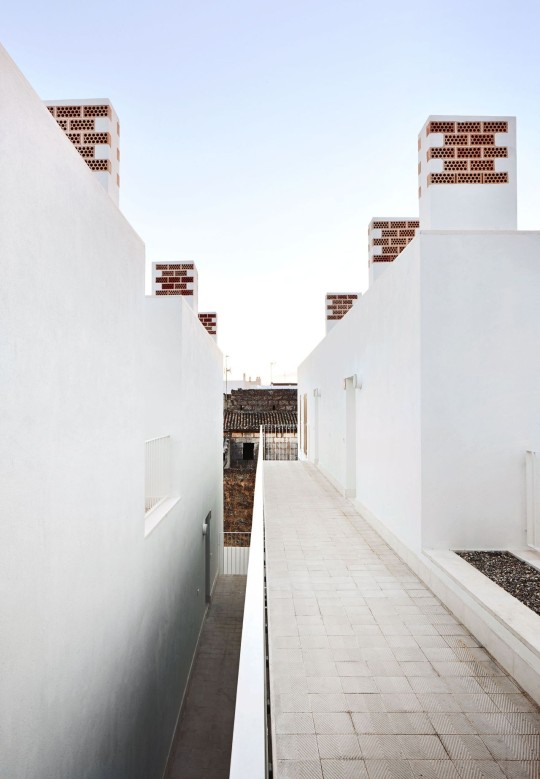
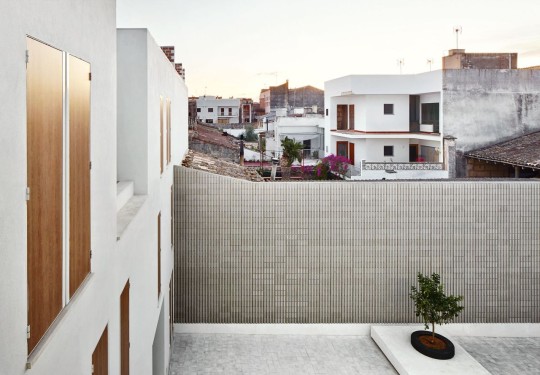


Social Housing in Sa Pobla, Majorca - RIPOLLTIZON
#RIPOLLTIZON#architecture#design#building#modern architecture#interiors#house#minimal#housing#social housing#beautiful design#light#render#balconies#courtyard#kitchen#low cost#chimney#majorca#spanish architecture
143 notes
·
View notes
Text
In this article, we will explore the world of 3D Walkthrough Animation helps Property Sales and how it can significantly boost your Real estate business. 3D walkthrough services provide architects and real estate developers with a competitive edge by enabling hyper-realistic visualizations of architectural concepts. These immersive 3D Walkthrough Animation showcase exterior and interior designs, even before construction.
#3D Walkthrough Animation#3D Architectural Walkthrough Services#3D Architectural Animation Services#3D Interior Walkthrough Animation#3D Exterior Walkthrough Animation#3D Real Estate Walkthrough Animation#3D Floor Plan Rendering Walkthrough Animation#3D Rendering Animation Services#3D Walkthrough Animation Presentation#Commercial 3D Walkthrough Animation#Residential 3D Walkthrough Animation#JMSD Consultant 3D Rendering Studio#BENEFITS OF 3D ARCHITECTURAL RENDERING WALKTHROUGH#Architectural 3D Walkthrough Animation project#3d walkthrough cost
1 note
·
View note
Text

Hey y’all! So, long story short: things feel through with my teaching job in Japan and I decided to come back home to the U.S. to continue my teaching career at the school I’ve previously worked at. They’re great people and have a supportive staff there and they have welcomed me back! The only issue is that I literally don’t have enough money to pay off some bills that I currently have. I have a lot of debt to pay off since I unfortunately did not have enough money to stay in Japan or anywhere else.
Anyways, I’m doing some emergency commissions so I can pay off two really important bills that need to be dealt with by the end of this week! My goal is to try to make at least $80 just to cover the bills until I am able to start working again (I’m supposed to start in the next two weeks but I’m not sure which day exactly yet). I’m opening up my commissions once again and I would like some help with my current situation.
I will be offering flat-colored pfp/icon commissions for $10!! There are some limits: I’ll only have time to draw one character at a time so if you want me to draw more than one character in your drawing, it will cost an extra $5.
Here are some examples of my work:




Depending on what you’d like me to do, I can easily go between a more cartoon-y style or a more ‘realistic’ style! Below are my basic rules and such:
What I will draw:
- Original characters
- Popular characters from books/tv shows/movies
- Animals/pets
- Monsters/cryptids/mythological creatures
- Backgrounds/settings/liminal spaces
- Robots
- Spooky themes (nothing with too much gore or explicit violence)
What I will NOT draw:
- NSFW art (I have nothing against it, I just don’t have an interest in drawing it)
- Complicated architecture (look at my art style…LOOK AT IT lol)
- No bigotry of any kind
- Realistically rendered art (again, look at my art style homie lol)
- No themes containing abuse or assault (especially, in regards to children)
- No HEAVY gore or violence
All commission requests can either be sent to me directly here on tumblr by message or sent to my art email [email protected]!
Here’s where I can take payment (or donations if you’re able to) from, just make sure you add a note about what you commissioned:
P4yp4al: @paranormalprairie
C4sh4pp: $jacksonjoycore
V3nmo: @lemonjack
If you can’t commission me, that’s a-okay! I would just appreciate y’all reblogging this as much as possible to spread it around. I’d really appreciate it!! Thank y’all for the endless support of my art. It’s been such a long road for me as a once traditional artist making such a big change to digital but I want to continue to get better and create even more amazing things to share with y’all! 💛🦁🌻
#pbscore#ok to reblog#my art#illustration#digital#digital art#digital drawing#digital commisions#drawing commisions#commision info#drawing commissions open#commissions#procreate art#procreate app#weirdcore#nostalgia#artists on tumblr#recoverycore#kidcore#nostalgiacore#artist support#artist commisions#digital illustration#furry artist#artists of color#latino artist#trans artist#black artist#cartoons#comics
129 notes
·
View notes
Text
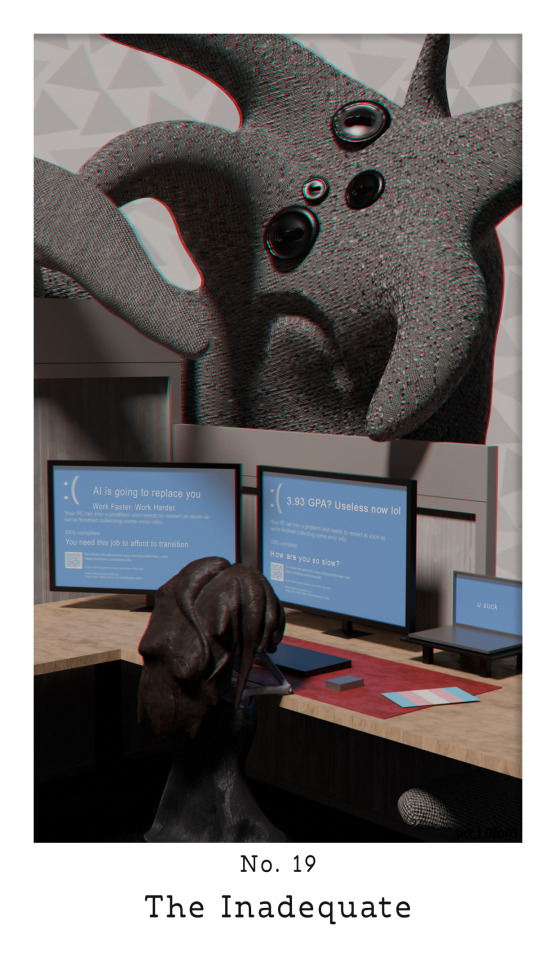
The inadequacy beast has been rather taxing lately.
I design buildings for a living. There is quite a lot that goes into the design of a building and architecture school can be rather intense as a result. It isn't uncommon for a professor to literally tear your project apart. Really, I have seen models ripped in half. This doesn't instill a sense of worth in what is produced. Even when grades didn't reflect this harsh criticism, I still carried it. It was good motivation to keep improving, even though it came at the cost of my pride.
The work place is different from architecture school. Where before I would at least get a grade at the end of a project saying I did good, now I have nothing. I am spending every day working on projects I barely receive feedback on, never knowing if I am too slow or not good enough. Constantly feeling inadequate. Architecture school is fantastic at teaching someone to make a variety of pretty renderings and write words about them. (That's all these posts are.) It is less good at teaching the reality that no one can afford anything nicer than a box. That buildings are actually stupidly detailed. That I barely learned anything at all.
Topping off this mental mess is the trans problem. I'm already so scared of losing this job. I feel like I can't risk being myself. I can't afford to give anyone any reason to dislike me, even if they're ultimately in the wrong.
I would be far worse off without this artistic outlet. I'm glad I can at least get some cool art out of this stress.
28 notes
·
View notes
Text
as promised - a slightly more detail post regarding digital art landscape/scenery/background commissions
i'm fine doing pretty much any kind of environment, including architecture - however, for more complicated stuff, i might need some extra reference pics as to what you have in mind, so id ask that you provide me with those
now, doing backgrounds/scenery isnt everyone's forte, and as someone who does in fact enjoy doing those: so long as you dont use it for commercial purposes + you credit me, you can use any landscape you commission from me as the background in your art! you can also simply toss me a backgroundless drawing of your character and i will add a background to it, either abstract or depicting an environment/space as specified by you
as for the prices, im dividing them into following categories:

sketches - depending on the desired amount of details/rendering, they range from $30 to $90 usd. if youre commissioning a full illustration i normally dont charge for sketches involved in the creation thereof, unless there ends up being a lot of them throughout the process of communicating the concept, in which case i will specify as needed (i will not pull out any surprise costs on you, dw)

thumbnail/concept/detail sketch sheets - also depending on complexity and the amount of drawings per page, but i estimate $50 for 5 sketches to the tune of the examples above

finally, illustrations - i start from $100 and go up from there, according to how robust the piece is going to be.
all in all, the best way to get a more specific price for what youd like, simply ask ^_^ knowing what exactly you have in mind, it'll be easy for me to estimate.
157 notes
·
View notes
Text
Today's Black History Month illustration is of Paul R. Williams, the first Black member of the American Institute of Architects.

Paul Revere Williams was born in Los Angeles in 1894 and was orphaned at four years old. Immediately after high school, he landed internships and jobs at local architecture firms despite the racial prejudice. Williams took classes at the Los Angeles Beaux-Arts School and then attended USC’s School of Engineering. He became a certified architect in 1915.

In 1920, Williiams was appointed to the first Los Angeles City Planning Commission, and the year after, he received a license to practice architecture in California and started working for John C. Austin. In 1922, he opened his own firm and served as an architect for the Navy during WWII. In 1923, Williams became the first Black person inducted into the American Institute of Architects.
He was an outstanding draftsman, and had the skill of rendering drawings upside down. He developed the skill so that his white clients (who might have been uncomfortable sitting next to a black architect) could see his drawings right side up across the table from him.
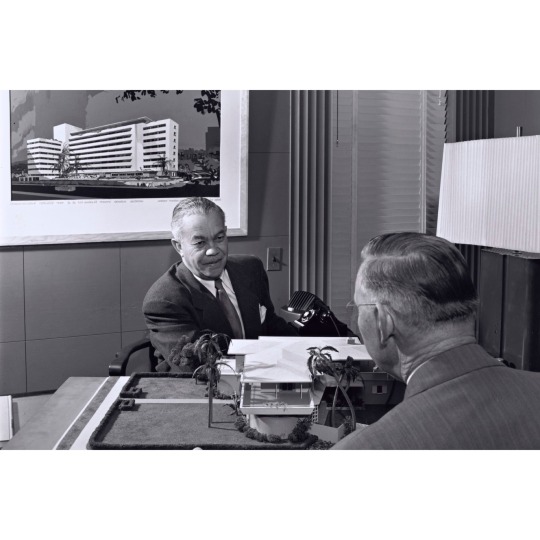
Williams designed over 2,000 homes, including the homes of Lucille Ball & Desi Arnaz, Frank Sinatra, Cary Grant, Humphrey Bogart and Lauren Bacall.

Along with designing homes for the wealthy and the stars, he designed affordable homes, public housing, civic, commercial and institutional buildings. Williams was also part of the Los Angeles International Airport (LAX) planning and design team.

Some of his works include the Golden State Mutual Life building in LA, St. Jude Children’s Hospital in Memphis, and the Los Angeles Superior Court.

He spearheaded the redesign of the Beverly Hills Hotel, a renovation which cost $3 million. The cursive letters on its sign are based on his own handwriting. Outside of LA, he remodeled buildings and spaces for Howard University (dentistry school, architecture and engineering college.)
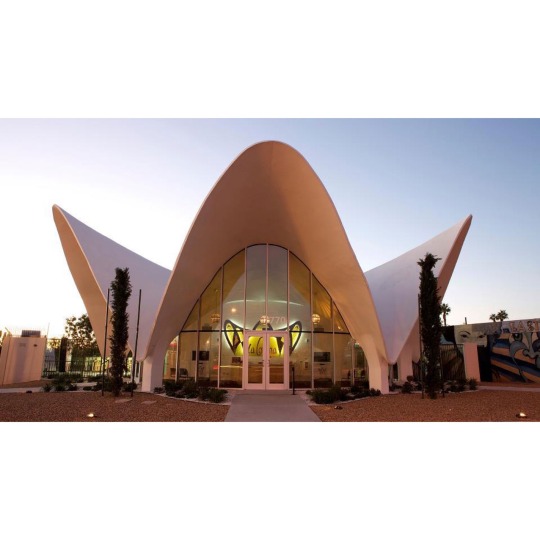
He received many awards including the NAACP Spingarn Medal and USC’s Distinguished Alumni Award. In 1957, he became the first African American to become an AIA Fellow. In 2017, Williams was posthumously awarded the AIA Gold Medal, America’s highest honor for an architect. He was the first Black architect to receive the Gold Medal.

Williams passed away in 1980 at 85, leaving a mark on West Coast architecture and aspiring Black architects.

I’ll be back tomorrow with another illustration and story!
#paul r. williams#black history matters#black history month 2023#black history facts#artists on tumblr#illustrators on tumblr
108 notes
·
View notes
Text
ACTUALLY. HOLY SHIT okay it's soooo topical that i was studying victorian literature this year because. there was a huge debate in the victorian era around the "condition of england" debate as it related to industrialization and art and its so unbelievably fucking applicable to what's happening with valkyrie during the war, with shu's view of art and perfectionism


so a big talking point during the victorian era was about industrialization and the role of the working class and how, effectively, they were being turned into materials or machines for the sake of "progress" - namely, the progress or benefit of the elite few at the cost of their humanity. this eventually extended into art . there's this guy john ruskin that wrote an entire thing called the stones of venice about the debate of perfection/imperfection in art, and how he believes that imperfection in art is necessary, because perfection in art/artisan craft (as was prized during the victorian era and in england) was achieved by "geniuses" at the cost of the humanity and individual creative spirit of "regular" people who could help them achieve this perfection in their craft by splitting the load. effectively, turning these humans into tools or machines for the "genius" creator to wield in order to achieve the perfect art.
sound familiar?
some quotes from ruskin's stones of venice:
"Understand this clearly: You can teach a man to draw a straight line, and to cut one [...] and to carve any number of given lines or forms, with admirable speed and perfect precision [...] but if you ask him to think about any of those forms [...] he stops; his execution becomes hesitating; he thinks, and ten to one he thinks wrong [...] he makes a mistake [...] but you have made of him a man for all that. He was only a machine before, an animated tool.
And, observe, you are put to stern choice in this matter. You must either make a tool of the creature, or a man of him. You cannot make both. Men were not intended to work with the accuracy of tools, to be precise and perfect in all their actions. If you will have that precision out of them [...] you must unhumanize them."
ruskin also has a few paragraphs talking about the idea that art or goods can be made both genuine and perfect by having a gentleman or artisan or genius design the form of the art/goods, and "common workmen" do the actual creation process, allowing for "design and finish". ruskin challenges this, saying that it's founded on "two mistaken suppositions" that 1) one person's thoughts can be accurately executed by another person's hands and 2) that the kind of manual labour necessary to actually make the finished products is a downgrade from the creative work of design
"We are always in these days endeavoring to separate the two; we want one man to be always be thinking, and another to always be working, and we call one a gentleman, and the other an operative. [...] As it is, we make both ungentle [...] and the mass of society is made up of morbid thinkers, and miserable workers."
"It seems a fantastic paradox, but it is nevertheless a most important truth, that no architecture can be truly noble which is not imperfect. [...] For since the architect, whom we will suppose capable of doing in all perfection, cannot execute the whole with his own hands, he must either make slaves of his workmen [...] or else he must take his workmen as he finds them, and let them show their weaknesses together with their strength, which will involve [...] imperfection, but render the whole work as noble as the intellect of the age can make it."
and finally: "But, accurately speaking, no good work whatever can be perfect, and the demand of perfection is always a sign of misunderstanding of the ends of art."
"but leo! shu makes all the costumes and songs and stuff for valkyrie the argument you make isn't true because it's not like shu ISN'T doing the work" I MEAN. OKAY. SURE shu IS doing a lot! but also it isn't necessarily the creation of the songs or the costumes or the choregraphy that's the focus here, the final "product" to be consumed. its the PERFORMANCE.
and mika and nazuna, during the exvalk days, essentially function like tools. their goal is to be honed to perform perfectly by shu's hand, in order to present the completely perfect final product that shu wants for his art. the analysis through ruskin's view of tools and perfection still applies, i think
anyways. i dont know if akira meant This much of an anything but it's really interesting to connect shu's victorian aesthetic of valkyrie and perfectionism at all costs to actual discourses happening in victorian england around art and perfection and industrialization and dehumanization. i hope it was meant as this much of a something i think that's a really fucking smart way to incorporate victorian debates into valkyrie and shu's characterization and i had fun pulling all this apart and putting things together
#leo liveblogs#leo composes#leo marionette lb#enstars#shu itsuki#also jesus this post is like 750 words what's wrong w me
53 notes
·
View notes
Text
talking about the economy with colleagues, stuff like the absurd housing market, the fact that the company counteroffer to our demand of a 10% cost of living adjustment in line with inflation is 0% (apparently we are losing money, someone should tell the people who keep hiring the fucking architecture render brigade we're almost certainly paying a fortune to for nonsensical development projects that will thankfully never happen), the fact that our union does not even appear to have the possibility of threatening a strike on their radar, which is probably for the best because the employees are so chickenshit and disorganized that the threat wouldn't be remotely credible, just the way everything is kinda generally turning to shit (and we didn't even mention the climate!)
they were talking about how "well if you're a young person these days who would ever like to own the place they live, or retire at all, you'd need to have a very different job to this one, this can maybe pay your bills and taxes but you're never going to save money let alone get a mortgage" and to them that's just what the world is like, that's just normal, we should all just find those well-paying jobs, and like, what if we did, my job isn't particularly critical to society but there are people whose jobs are absolutely essential and they get paid even less than we do, what do we do if they all decide to find a job that will let them retire someday huh, hell a lot of kids are trying that right now with becoming lawyers and really I don't know how many lawyers they think a society can sustain
what people end up on ultimately is that in our society there are people who deserve to maybe survive day-to-day, week-to-week, people who get to have a comfortable but insecure life, and people who have literally more money than they could ever imagine spending, and this is reasonable and really the only way you could organize society
I don't understand how people can end up at this reasoning and find it satisfactory, how they can think "well of course the underclass must exist and is just going to eat shit forever, and the only thing I should do is pray that I'm just barely above that", how can you consider that a society (a democratic one, apparently)
85 notes
·
View notes
Text
ok one last post about the Project to truly exorcise it from my brain. just some process/design thoughts (also now that it's done if you want to read my liveblogged whinging for whatever reason here it is)
first off some stats because i kept stats like the nerd that i am:
time wise making this animatic took about 93.5 hours give or take (thanks procreate process replay) spread across exactly 2 months
anyway when i said i finished this project mostly through stubbornness and sunk cost fallacy this is what i meant lol like a lot of my thought process through this was just 'no way in hell am i letting some of these drawings disappear into my drafts forever'

on average each frame took about 2 hours 45 minutes but thats a bit of an overestimate since i forgot to count some of the animated bits from the first two lines (so id guess the actual number is more like.. 2 hours 20 minutes?)
btw that line with the starry apparition fading away? 12 hours total
the single longest and most painful frame to draw was the one of the crew walking through tu'narath (5 hours 30 minutes) because a. perspective b. architecture design c. for some reason i put a lot of detail into rendering the armour on all the githyanki i drew why on earth did i do that
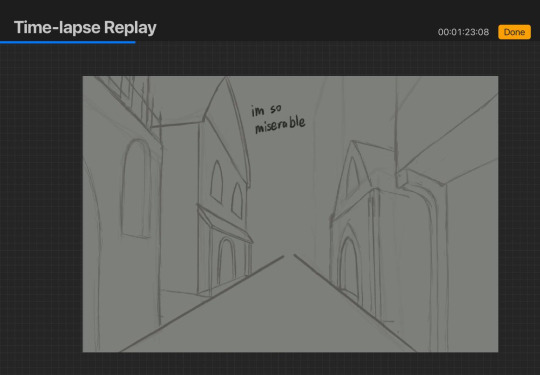
(its especially painful bc that frame was one of the ones that didnt... feel like an important enough moment in the actual story of the show to be worth capturing the way the wish or even like, endellion is, i just needed to put that there for the storytelling flow or whatever of the animatic itself and it bothered me so much)
one other interesting little mishap was that i did all of these on canvas size 1080x720px (so that's why the youtube resolution isnt particularly high lmao) which is why procreate let me put an absolutely absurd amount of layers in one canvas (all 8 frames of with memories projected on the astral sea were done on one canvas. 159 layers) because the layer limit for that canvas size is 400 BUT. i accidentally started the starry apparition fade on an A4 canvas (my default canvas size for like all my normal fanart) and i only realised after finishing all the lineart and starting on colouring because i hit layer limit so i had to resize the canvas which did... interesting?? things to the lineart resolution
also if youre wondering how i drew K-LB that many times in something resembling timely fashion the answer is i sacrificed some... amount of sleep to 3d model and rig him in blender which. honestly? i consider it a roaring success
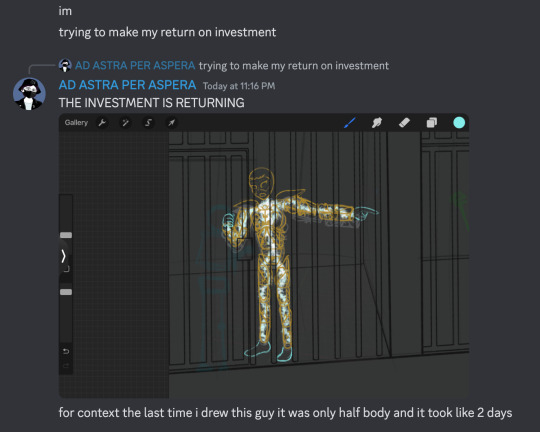
splitting the frames by bar was a Choice and certainly a choice ive.. had doubtsTM about but thats the kind of thing you cant really change without bringing the whole project crashing down so if the frames seem to move a bit too fast im so sorry there was really not much i could do there
idk if people actually noticed the very very tiny drawings of the crew moving around on the ship in the 4th line especially since they sometimes get obscured by the subtitles but the REASON for that is in my original drawings the subtitles went in the top left corner but they kept conflicting with other stuff so i just gave up and threw them to the bottom (also i originally included the chinese lyrics but then i got lazy lmao)
anyway that little detail like VR-LA angstily looking at the sea reminiscing about the JourneyTM and the crew sort of appearing along with the memories of their adventures together was one of those things that seemed SO COOL in my head but once i actually execute it its like. hmmmm not sure if that worked out the way you thought it would buddy. also the tiny crew was EXTREMELY hard to draw so put that down as another point in 'me subjecting myself to deeply painful and out there compositions for no good reason'
anyway i called this my magnum opus but i do actually have some thoughts about another one (a companion piece, if you will) for another song by the same band because now that i know what capcut can do im.. really itching to try something a little different because this like powerpoint presentation style? fully a product of me using iMovie as my only available video editing software for the past like 7 years of my life
#rwd#asto speaks#re: the projectTM#one last time using this dumbass tag lmao#honestly? also put another point in 'i worked on a project for so long it became just a Project to me and proceeded to get#absolutely blindsided by the emotional affect it has on people'#2 months. 2. months.#whatever actual emotion this idea was originally trying to draw from is long fucking gone buddy#like i did manage to re-experience some of it looking at the finished product but#i appreciate yalls screaming a lot i just truly did not anticipate it LMAO
5 notes
·
View notes
Text
Architectural Visualization and Rendering Services providers Washington DC
Looking for 3D Rendering Services Washington DC? JMSD Consultant Architectural Rendering as an outsourcing partner in Washington DC That sounds like a very impressive and valuable service! Hyper-realistic 3D renderings and animations can really help potential buyers or investors get a better sense of what a property looks like and how it might feel to be inside it, even if they haven’t had a chance to visit it in person yet. And the fact that JMSD Consultant Rendering Company in Washington DC has over a decade of experience and has worked with so many clients across multiple states is a testament to their expertise and professionalism. I’m sure many real estate companies and developers would benefit from their services.
#3D Rendering Services Washington DC#3D Exterior House Rendering in Washington DC#Top 3D Architectural Rendering Services in Washington DC#Architectural Rendering as an outsourcing partner in Washington DC#JMSD Consultant 𝟯𝗗 𝗥𝗲𝗻𝗱𝗲𝗿𝗶𝗻𝗴 𝗰𝗼𝗺𝗽𝗮𝗻𝘆 𝗪𝗮𝘀𝗵𝗶𝗻𝗴𝘁𝗼𝗻 𝗗𝗖#Architectural 3D Rendering Services Washington DC#3D Rendering Experts in Washington DC#average cost for architectural rendering in Washington DC#3D Rendering Services for Property Developers Washington DC#Architectural Visualization and Rendering Services providers Washington DC
1 note
·
View note
Text
Unlocking Luxury Living: Prestigious Residential Islands in Dubai
Revealing the Opulence of Exclusive Island Properties and Their Impact on Dubai's Luxury Real Estate Market
Luxury residential islands in Dubai, exemplified by The World Islands and Palm Jumeirah, have had a profound influence on the city's real estate landscape. These man-made marvels offer a distinctive and lavish living experience that magnetizes affluent individuals and investors worldwide. Their allure extends beyond mere luxury; they are beacons of elite living, drawing colossal investments and epitomizing opulence. In this discourse, we delve into the financial advantages of luxury living on Dubai's islands, exploring key aspects that underpin their allure and exclusivity.
1. Prestigious Real Estate Developments
The World Islands and Palm Jumeirah stand as epitomes of luxury living on Dubai's islands. Engineered to perfection, these islands boast waterfront residences with breathtaking vistas and private beaches. Their unparalleled uniqueness has propelled their desirability, resulting in soaring demand and exorbitant prices.
2. Exclusive Island Properties
Synonymous with exclusivity and prestige, luxury residential islands cater to discerning clientele seeking unparalleled opulence. Mada properties are adorned with lavish amenities and exquisite finishes, enticing individuals who are willing to splurge for a lifestyle that sets them apart.
3. Attraction for International Investors
Dubai's allure for international investors is perennial, with prestigious developments like luxury residential islands being prime attractions. The prospect of owning an exclusive island property in a city renowned for modernity and economic opportunities is irresistible, driving demand and augmenting the luxury real estate market's value.
4. Tourism and Hospitality
Beyond residential appeal, luxury residential islands double up as tourist attractions, fueling demand for high-end accommodations. Many properties are managed by renowned hospitality brands, offering residents hotel-like services amidst luxurious island living.
5. Infrastructure and Connectivity
The development of luxury residential islands has spurred infrastructure enhancements, including roads, bridges, and transportation networks, rendering these locales more accessible. Improved connectivity not only benefits island residents but also enhances the appeal of surrounding areas.
6. Impact on Pricing
Exclusivity and limited availability have propelled premium pricing for island properties, setting benchmarks for luxury real estate. The most coveted residences, nestled on Palm Jumeirah and The World Islands, command staggering prices, reflecting their unparalleled status.
7. Impact on Surrounding Areas
The presence of luxury residential islands has catalyzed growth in surrounding neighborhoods, driving up demand, development, and property values. The islands' allure radiates across the vicinity, elevating the appeal and desirability of adjacent areas.
8. Economic Diversification
Dubai's real estate sector, including luxury island properties, plays a pivotal role in the city's economic diversification efforts. Revenue generated from these developments fuels growth across various sectors, contributing to Dubai's resilience and prosperity.
9. Challenges and Vulnerabilities
Despite their success, luxury residential islands grapple with challenges, including environmental concerns and maintenance costs. Sustaining these artificial paradises necessitates continuous investment, underscoring the financial commitment involved.
10. High-end Waterfront Residences
The allure of living directly on the waterfront is a primary draw for island residents. The serene ambiance, panoramic views, and direct access to the sea epitomize luxury island living, fueling demand for waterfront properties.
11. Iconic Architecture and Design
Properties on luxury islands boast iconic and innovative architectural designs, showcasing unparalleled luxury and sophistication. Each structure is a testament to cutting-edge design and craftsmanship, adding to the allure and value of these prestigious developments.
12. High-End Amenities
Luxury island living is synonymous with grandiose amenities, including private beaches, marinas, golf courses, and Michelin-starred restaurants. These amenities cater to the affluent elite, offering an unparalleled lifestyle experience that epitomizes luxury living.
In conclusion, luxury residential islands like The World Islands and Palm Jumeirah have redefined Dubai's real estate landscape. They epitomize opulence, attracting high-net-worth individuals and international investors while catalyzing growth in surrounding areas. As symbols of Dubai's ambition and extravagance, these exclusive island properties continue to captivate the world of luxury real estate.
2 notes
·
View notes
Text
Maximizing Test Effectiveness: Unraveling the Advantages of Selenium in Web Testing
Introduction: Selenium, a prominent automation testing framework, has redefined the landscape of web application testing. Renowned for its versatility, user-friendliness, and robust capabilities, Selenium is an indispensable asset for professionals engaged in software testing. In this discourse, we explore the manifold advantages of utilizing Selenium for web testing and elucidate how it empowers testers to achieve optimal outcomes.

1. Precision and Dependability: Selenium provides precise and dependable element identification, enabling testers to accurately pinpoint and interact with web elements on a page. Leveraging unique attributes such as IDs, classes, or XPath expressions, Selenium ensures tests execute consistently and yield reliable results across various browsers and environments.
2. Enhanced Test Stability: Selenium bolsters test stability by mitigating the impact of changes in the application under test. Selenium locators are adept at withstanding alterations in page layout or structure, ensuring tests remain stable and impervious to minor UI modifications. This stability is pivotal for upholding the integrity of test suites and ensuring accurate validation of application functionality.
3. Improved Test Efficiency: Leveraging Selenium for web testing enhances efficiency and productivity by automating repetitive testing tasks. By automating routine test cases, testers can allocate their time and effort toward more intricate scenarios and exploratory testing, thereby expediting the overall testing process and reducing time-to-market for web applications.
4. Cross-Browser Compatibility: A standout feature of Selenium is its cross-browser compatibility, facilitating test execution across diverse web browsers with minimal effort. Selenium WebDriver seamlessly supports popular browsers like Chrome, Firefox, Safari, and Edge, ensuring consistent test execution and compatibility across varied browser environments.

5. Seamless Integration with Testing Frameworks: Selenium seamlessly integrates with a myriad of testing frameworks, enabling testers to harness their preferred tools and methodologies. Whether utilizing TestNG, JUnit, or NUnit, Selenium can be effortlessly integrated into existing testing workflows, affording flexibility and customization options tailored to the needs of individual testing teams.
6. Scalability and Reusability: Selenium advocates scalability and reusability through its modular test design and component-based architecture. Test scripts and components can be modularized and repurposed across multiple test cases, curbing duplication of effort and maintenance overhead. This modular approach fosters test maintainability and facilitates the creation of robust, scalable test suites.
7. Cost-Effectiveness: By automating web testing tasks, Selenium aids organizations in trimming manual testing efforts and associated costs. Automated tests can be executed repeatedly sans additional expenses, resulting in long-term cost savings and heightened return on investment. Additionally, Selenium's open-source nature obviates licensing fees, rendering it a cost-effective choice for organizations of all sizes.
8. Comprehensive Test Coverage: Selenium empowers testers to attain comprehensive test coverage by supporting a gamut of testing scenarios and workflows. From functional and regression testing to performance and compatibility testing, Selenium caters to diverse testing requirements, ensuring thorough validation of web applications across various dimensions.
In summation, Selenium offers a plethora of advantages for web testing, encompassing precision and reliability, enhanced test stability, improved efficiency, cross-browser compatibility, seamless integration, scalability, cost-effectiveness, and comprehensive test coverage. By harnessing the power of Selenium, testers can streamline their testing endeavors, augment test coverage, and deliver high-quality web applications that align with the expectations of end-users and stakeholders alike.
2 notes
·
View notes
Text
Terrance Stevens and Forton Services
Forton Services
Highway service station
Combines brutalist architecture with liminality. Hypothesized by Terrance Stevens to be capable of inducing strong psychological responses
17.7 acre site
Pennine Tower: 20 meters (closed to the public)
Top of the tower used to house a restaurant, which was eventually closed down. Space was subject to later failed attempts to be repurposed
Elevator shafts were eventually replaced in 2017, rendering the top floors inaccessible
Terrance Stevens
51
Underwent a divorce which cost him his social life
Quit his job (deputy fiduciary services administrator) to become a janitor at Forton Services
Simultaneously applied for Architecture Program at Lancashire University
During his months of employment at Forton Services, he noticed consistent decrease in patronage
When the night came that he saw nobody at all, he went outside to check the parking lot, where he saw strange, fog-like streaks of light which resembled long-exposure photography
This was "accompanied by a disquieting sense of absence. Of hunger."
The "glowing mist" gradually made its way into the building
Saw a woman, "tall, young, and thin, almost to the point of malnourishment, dressed similarly to a stewardess with a tightly fitting blue waistcoat buttoned over a sensible-looking grey skirt" with a golden name badge that read "You are here," smiling and holding the elevator for him
When he gets into the elevator to escape the fog, she presses the button to take them to the closed restaurant
The button is disabled, but the elevator takes them there anyways
"Good evening! You are here! Stay awhile!"
The restaurant, which should've been dark and empty, was bustling with strange people who shared clothes and features and whose speech was incoherent background noise. Like the woman, they were painfully thin and told Stevens "you are here! Stay awhile!"
The blacked-out windows were replaced with holes void of glass or other material, opening out into a dark, featureless nothing
Repeating "stay awhile", the strange people surrounded and began biting Stevens, removing one of his fingers
Stevens escaped by fighting them off and jumping out one of the windows
He awoke surrounded my paramedics who assured him his injuries were related to the trauma of his fall, which was brought on by a psychotic episode
None of his colleagues, teachers, or students noticed his absence or reported him missing despite his extended absence
He wrote an essay entitled "Forton’s Brutal Liminality – a case study of architecturally induced psychological stressors as a result of prolonged exposure to liminal spaces in the brutalist mode, as exhibited by Forton Service Station" which he received a failing grade on due to late submission
4 notes
·
View notes
Text
Elevating Your Full-Stack Developer Expertise: Exploring Emerging Skills and Technologies
Introduction: In the dynamic landscape of web development, staying at the forefront requires continuous learning and adaptation. Full-stack developers play a pivotal role in crafting modern web applications, balancing frontend finesse with backend robustness. This guide delves into the evolving skills and technologies that can propel full-stack developers to new heights of expertise and innovation.

Pioneering Progress: Key Skills for Full-Stack Developers
1. Innovating with Microservices Architecture:
Microservices have redefined application development, offering scalability and flexibility in the face of complexity. Mastery of frameworks like Kubernetes and Docker empowers developers to architect, deploy, and manage microservices efficiently. By breaking down monolithic applications into modular components, developers can iterate rapidly and respond to changing requirements with agility.
2. Embracing Serverless Computing:
The advent of serverless architecture has revolutionized infrastructure management, freeing developers from the burdens of server maintenance. Platforms such as AWS Lambda and Azure Functions enable developers to focus solely on code development, driving efficiency and cost-effectiveness. Embrace serverless computing to build scalable, event-driven applications that adapt seamlessly to fluctuating workloads.
3. Crafting Progressive Web Experiences (PWEs):
Progressive Web Apps (PWAs) herald a new era of web development, delivering native app-like experiences within the browser. Harness the power of technologies like Service Workers and Web App Manifests to create PWAs that are fast, reliable, and engaging. With features like offline functionality and push notifications, PWAs blur the lines between web and mobile, captivating users and enhancing engagement.
4. Harnessing GraphQL for Flexible Data Management:
GraphQL has emerged as a versatile alternative to RESTful APIs, offering a unified interface for data fetching and manipulation. Dive into GraphQL's intuitive query language and schema-driven approach to simplify data interactions and optimize performance. With GraphQL, developers can fetch precisely the data they need, minimizing overhead and maximizing efficiency.

5. Unlocking Potential with Jamstack Development:
Jamstack architecture empowers developers to build fast, secure, and scalable web applications using modern tools and practices. Explore frameworks like Gatsby and Next.js to leverage pre-rendering, serverless functions, and CDN caching. By decoupling frontend presentation from backend logic, Jamstack enables developers to deliver blazing-fast experiences that delight users and drive engagement.
6. Integrating Headless CMS for Content Flexibility:
Headless CMS platforms offer developers unprecedented control over content management, enabling seamless integration with frontend frameworks. Explore platforms like Contentful and Strapi to decouple content creation from presentation, facilitating dynamic and personalized experiences across channels. With headless CMS, developers can iterate quickly and deliver content-driven applications with ease.
7. Optimizing Single Page Applications (SPAs) for Performance:
Single Page Applications (SPAs) provide immersive user experiences but require careful optimization to ensure performance and responsiveness. Implement techniques like lazy loading and server-side rendering to minimize load times and enhance interactivity. By optimizing resource delivery and prioritizing critical content, developers can create SPAs that deliver a seamless and engaging user experience.
8. Infusing Intelligence with Machine Learning and AI:
Machine learning and artificial intelligence open new frontiers for full-stack developers, enabling intelligent features and personalized experiences. Dive into frameworks like TensorFlow.js and PyTorch.js to build recommendation systems, predictive analytics, and natural language processing capabilities. By harnessing the power of machine learning, developers can create smarter, more adaptive applications that anticipate user needs and preferences.
9. Safeguarding Applications with Cybersecurity Best Practices:
As cyber threats continue to evolve, cybersecurity remains a critical concern for developers and organizations alike. Stay informed about common vulnerabilities and adhere to best practices for securing applications and user data. By implementing robust security measures and proactive monitoring, developers can protect against potential threats and safeguard the integrity of their applications.
10. Streamlining Development with CI/CD Pipelines:
Continuous Integration and Deployment (CI/CD) pipelines are essential for accelerating development workflows and ensuring code quality and reliability. Explore tools like Jenkins, CircleCI, and GitLab CI/CD to automate testing, integration, and deployment processes. By embracing CI/CD best practices, developers can deliver updates and features with confidence, driving innovation and agility in their development cycles.
#full stack developer#education#information#full stack web development#front end development#web development#frameworks#technology#backend#full stack developer course
2 notes
·
View notes
Text
Cloud Aspirations: The Optimal AWS Certification for Fresh Entrants
Introduction: Setting Sail into the Cloud Horizon
In the ever-expansive world of cloud computing, AWS emerges as a guiding force, beckoning individuals with a myriad of opportunities to carve their niche in this burgeoning industry. For newcomers eager to embark on a cloud-centric journey, the choice of the right AWS certification serves as a pivotal decision. One certification, often hailed for its adaptability and foundational wisdom, is the AWS Certified Solutions Architect - Associate. With the aid of AWS Training in Pune, professionals can acquire the expertise needed to harness AWS capabilities across diverse applications and industries.

Exploring the Preferred Starting Point: AWS Certified Solutions Architect - Associate
Dive into why this certification is deemed the ideal launchpad for newcomers aspiring to secure a foothold in the domain of cloud computing.
1. Establishing the Bedrock with AWS Certified Solutions Architect - Associate:
Functioning as an entry point, the certification lays a robust foundation in AWS services and architectural best practices. It equips individuals with the indispensable skills necessary to conceive scalable, secure, and cost-effective solutions on the AWS platform.
2. Meeting Industry Demands:
Employers actively seek professionals adept at designing and implementing AWS solutions. The Solutions Architect certification, finely tuned to job roles, aligns seamlessly with industry demands, rendering certified individuals highly coveted in the job market.
3. Application-Oriented Learning for Real-world Challenges:
This certification places emphasis on practical application, ensuring certified individuals not only comprehend theoretical concepts but also wield the ability to apply this knowledge to real-world scenarios. The practical approach hones problem-solving skills, preparing candidates for the challenges encountered in professional landscapes.
4. Versatility Across Industry Spectrums:
Skills acquired through the AWS Certified Solutions Architect - Associate certification are versatile and applicable across diverse industries—be it finance, healthcare, or technology. The imbibed principles are invaluable, empowering newcomers to explore varied career trajectories within AWS. To delve deeper into AWS intricacies and unlock its full potential, individuals can find enrichment through enrolling in the Finest AWS Online Training.

5. Accessible Entry for Novice Professionals:
In contrast to some advanced certifications demanding extensive experience, the Solutions Architect - Associate certification is accessible for entry-level professionals. While a basic grasp of cloud concepts proves beneficial, the certification is thoughtfully crafted to provide foundational knowledge to individuals taking their initial steps into AWS.
Charting a Path for Career Advancements:
A certified AWS Solutions Architect - Associate not only gains a competitive edge in the job market but also lays the groundwork for future career advancements within the AWS ecosystem. Serving as a stepping stone, this certification swings open doors to more specialized and advanced certifications as individuals accumulate hands-on experience.
Conclusion: Gateway to a Cloud-Centric Odyssey:
In conclusion, for aspiring individuals poised to launch a career in cloud computing, the AWS Certified Solutions Architect - Associate certification emerges as a strategic choice. It bestows a holistic understanding of AWS services, architectural best practices, and practical wisdom. As the ever-evolving cloud computing landscape continues its metamorphosis, possessing this certification on your resume positions you as a prized asset in the dynamic and growing field of AWS.
Embark on your cloud journey, absorb the foundational knowledge bestowed by the Solutions Architect - Associate certification, and unlatch the doors to a fulfilling career in the expansive world of Amazon Web Services.
2 notes
·
View notes
Text
In defense of Brutalism: An appeal for 21st century revival
Coming into prominence during the reconstruction period following the Second World War, the architecture movement widely known as Brutalism was born out of a need for affordable and functional construction in Europe. Rebuilding efforts in Europe were influenced by socialism and embraced the ideals of utilitarianism, austerity, and low cost. Brutalism, not only holding to those ideals, also stems from the already existing Modern architecture movement, where functionalism is favored to form, and minimalism is preferred to heavily ornamental designs. It remained a popular architectural style in the mid-20th century, lasting until the late 1970s.
Recognizable by – and quite literally defined by – the raw materials and structural elements of construction, the term “Brutalism” is derived from the French phrase “béton brut,” meaning “raw concrete,” a nod to the exaggerated and exposed concrete which is signature to all Brutalist buildings. The phrase was made popular by Brutalist pioneer, architect Le Corbusier. By highlighting the building material’s structural elements as integral parts of the design, Brutalist architects created visually harsh edifices that render power. Beyond that, other characteristics of the movement are strong cubic form, deep set windows, top-heavy designs, and the monochromatic tones. Using cast concrete lends itself to geometric, repetitive designs, creating a rational, robust style. It was not the explicit intent of Brutalist architects to create foreboding structures, but the powerful and weighty buildings that emerged from these principles of design cannot be viewed passively by a visitor. Because of this, Brutalism often evokes visceral reactions of either admiration or frustration.
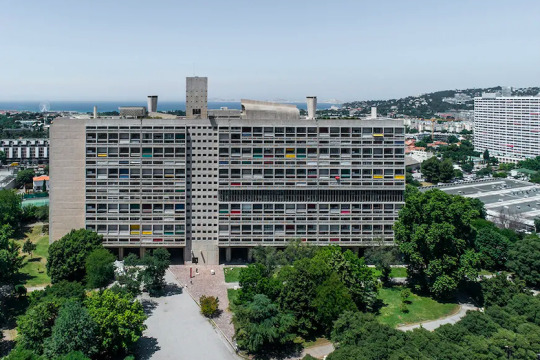


Unité d'habitation, Marsielle, France
Designed by Le Corbusier
Beyond the physical elements of Brutalist architecture, there are the social and political philosophies behind it. Though this architectural movement was not backed by a specific school of artists or thought, Brutalism was used by architects to create a social narrative and conversation about habitation ethics. There was “a growing desire amongst architects, urban designers and planners to restore human scale in cities and honesty of materials in the construction of buildings; in other words, they wished to combine social and architectural considerations”, prioritizing ethic over aesthetic.
1950s American architecture had become dominated by homogenous sleek and non-decorative buildings, an aesthetic referred to as the "International Style". Originally revered as the look of modernity, International Style buildings were alienating, boring, and unappealing. They became symbolic of corporate culture conformity and did not relate to each other or the space around them in a way that created desirable, socially integrated spaces. The pursuit of a solution to this “human and architectural crisis” that emerged allowed the space for Brutalism to thrive in the U.S.
Architects and thinkers like American Paul Rudolph saw Brutalism as a way to positively impact people’s lives and outlook. The 1960s gave rise to a more humanist-centered architectural approach, pivoting from the monotonous, unexpressive International Style in favor of irregular, monumental, and futuristic silhouettes offered by Brutalism. At the same time, the progressive leadership of President John F. Kennedy and the Great Society agenda developed under Lyndon B. Johnson left the ideal opening for Brutalism to take hold. A period of growth for the U.S. coincided with the rise of Brutalism and “at a moment when the United States was enjoying great prosperity and political influence, Brutalism’s large-scale monumentality answered the desires of political authorities to give architectural expression to their Great Society ambitions." Brutalist style precisely captured the dignity, stability, economic confidence, and desire for a strong public sector that the United States was striving for. It also embodied a rebellion against the cookie-cutter, commercial homogeny of the suburbs and disdain for bureaucratic faultiness.
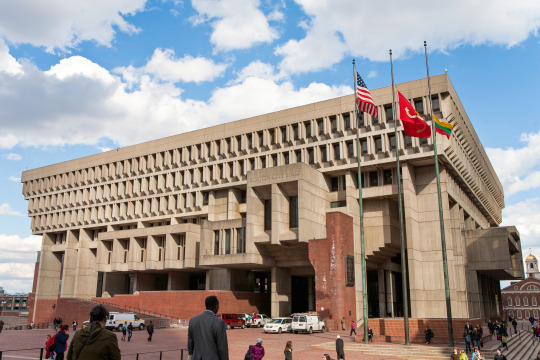
Boston City Hall, Boston, MA
Designed by Micheal McKinnell and Gerhard Kallmann

Washington D.C. Metro
Designed by Harry Weese
Peaking in the United States in the 1960s and 1970s, Brutalist architecture began to fall out of favor, eventually becoming what is arguably one of the most contested modern architecture movements across the globe, specifically in the U.S. As recent as 2020 under the Trump Administration, an executive order was passed prohibiting further construction of Federal buildings in anything but “beautiful” classic architecture. The order explicitly called out the Brutalist style as one of bad taste, saying that "since the mid-20th century, Modernist mandarins controlling government architecture have been forcing ugly designs upon us." The order goes on to say that “new Federal building designs should, like America’s beloved landmark buildings, uplift and beautify public spaces, inspire the human spirit, ennoble the United States, command respect from the general public, and, as appropriate, respect the architectural heritage of a region." The commentary in former President Trump’s executive order evokes another reason for the Brutalist downfall – the association with communist Russia, as the Brutalist style was used in ultimately failed Soviet public housing and that of other communist countries following WWII.
The style was also the choice of private developers hoping to use unique Brutalist housing to replace neglected urban neighborhoods in cities like Boston and Washington D.C. to entice wealthier, white residents to remain in the city instead of moving to the suburbs, the migration referred to as “white flight” in the 1960s. But the resulting "urban renewal" efforts in American cities proved just as unsatisfactory as those in Soviet Russia, if not downright malicious. By clearing out urban "slums" and tearing down the existing housing, urban planners displaced communities and culture, only to replace them with experimental Brutalist housing complexes they had no intention of maintaining.

Stevenson Commons in the Bronx, New York, NY
Brutalism in United States cities was the epitome of architecture and urban planning centered on aesthetics without the ethics – the opposite of Brutalism’s original aims. It inevitably led to devastating effects on communities and a nearly universal sentiment that Brutalism had failed to appeal and meet the needs of people. By totally neglecting and skewing the original intentions of the design, "social, political, and economic elites used Brutalism to write power and privilege onto urban landscapes in an effort to redraw the boundaries of American democracy” to favor themselves and further disrupt marginalized populations.
There is poignant irony in this being the way Brutalism was implemented in the U.S., given that the intention of the style was to symbolize optimism, equity, and aspiration, not paranoia and exploitation. Possibly because of Brutalism’s decentralized ideology, over time “its function as a means for the demonstration of hierarchies of power changing. Once conceived of as a language of form designed to articulate ideas and practices of equality and inclusion, it was increasingly reinterpreted as a way of inscribing elite power and privilege into urban space." This shift was exceptionally significant and highlighted in the United States.
Situations like this playing out in U.S. cities were used as neoliberal arguments against public housing. "Step outside in the worst estates and you're confronted by concrete slabs dropped from on high, brutal high-rise towers and dark alleyways that are a gift to criminals and drug dealers." This solidified the public’s connotation of Brutalism as a symbol of urban decay, and overreaching public sector, and totalitarianism.
The Brutalist experiment also proved to be a fundamental failure in branding. Despite efforts to rebrand with phrasing such as “heroic”, to strike a less intimidating tone, Brutalism has remained the dominant idiom, often misconstrued as a reference to the severe look and impact of the buildings and not the French origins of the word. It was very easy to blame the before mentioned issues on a structure and style that had “bad” connotations, which had effectively gone out of style, rather than admit the failure of urban planning.
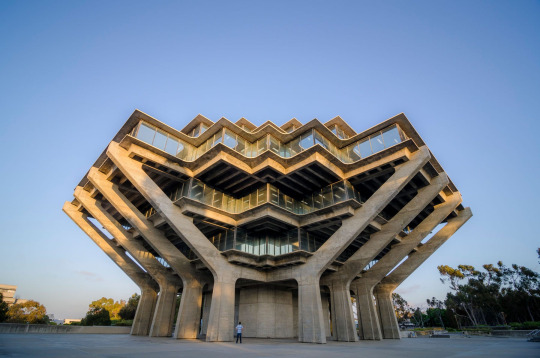
Geisel Library (University of California, San Diego), San Diego, CA
Designed by William Pereira


Solomon R. Guggenheim Museum, New York, NY
Designed by Frank Lloyd Wright
If the founding principles and purposes of Brutalism are adhered to, the architectural style presents a great deal of potential to serve as a vehicle for community building and affordable, equitable housing in urban regions. The failings of Brutalism are superimposed on the style, results of racist and careless planning combined with meager upkeep. The structures and designs themselves are not to blame for the crime and substandard conditions that plagued them. More accurately the management of the buildings and deliberate neglect of them lead the Brutalism’s shortcomings and the demolition of many Brutalist buildings from this period.
Successful implementation of the intended Brutalist ideals in future housing projects, as well as the protection of current buildings will undoubtedly prove to be beneficial moving forward. First, concrete remains a valuable material for construction. Shape and form that are not possible with traditional wood or steel framing is possible, allowing architects to act as artists, pushing the boundaries of what buildings are expected to look like. Though cement – the primary ingredient in concrete – creates carbon dioxide in production, concrete can reduce the energy needed for heating and cooling by retaining heat in the winter and keeping cool in the summer. Cast concrete remains versatile and affordable, and the previous mistakes of Brutalism can be more effectively mitigated, so that construction can be efficient but still produce refreshing, creative, and community-centered structures.
Second, as we move into a new political and social era, the Brutalist architecture of a historic period where the public sphere was prioritized could have legitimate appeal. Through its ethics and aesthetics, Brutalism reflects a time a great hope and represents honesty, idealism, and hubris. The buildings have "visual sensibility combined with a desire for good social planning and an honest expression of materiality, construction and refined detailing. [They are] ‘uncompromising, pioneering, forward-looking and expressed modernity.'"
Lastly, there are examples of current Brutalist buildings that have been hailed as beloved structures by the public, and effectively revived via creative methodology and upkeep. For example, the Hirshhorn Museum shows how the use of color and light displays on the typically bleak, monochromatic walls of a Brutalist building can draw attention and eventually affection from visitors.

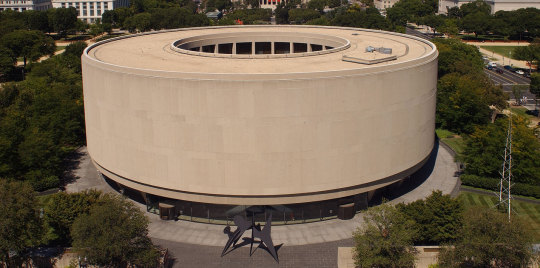

Hirshhorn Museum and Sculpture Garden, Washington, D.C.
Designed by Gordon Bunshaft
Our culture today is perhaps more hyper-consumerist, convenience-driven, and commercialized than it was in the 1960s and 1970s when Brutalism made its claim in the American urban landscape. I believe that now, more than ever, the intentional, stimulating, and unique design of Brutalist architecture is needed to re-humanize structures and community spaces. Returning to the origins of the Brutalist counterculture, the holistic construction method and visual features can draw residents in, provide perspective, inspiration, and a sense of camaraderie could prove a solution to modern urban planning challenges.
And though visually Brutalist buildings do not evoke the same immediate associations with “democratic ideals” as Greco-Roman styles, the grandiosity, audaciousness, and sublime greatness of Brutalism ultimately demonstrates the same heroic narrative of a strong democratic nation. When evaluated through the lens of ethics, correctly executed Brutalist architecture is forward looking to modernity where urban landscapes are not built homogeneously and lazily, but with intention and relatability. As an editorial writer for the Washington Post puts it, "while glass buildings seem transient, Brutalist buildings seem to know they will outlast us. To stand in front of one is to be humbled, to be confronted by a chunk of eternity. That can be comforting — or disconcerting; I choose to view it as a comfort." Using the pragmatic construction and preservation of Brutalist architecture, I believe it is both possible and necessary to create utilitarian housing and urban structures that can withstand the test of time in both ethics and aesthetic — it might just take a little reframing.
Read more:
#brutalism#modern architecture#concrete#le corbusier#brutalist#housing#utilitarianarchitecture#hirshhorn#washington dc#politics#20th century#democracy#city planning#urban architecture
12 notes
·
View notes